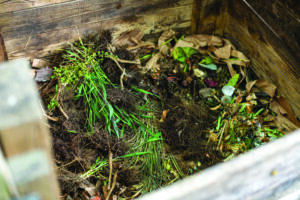
Grass clippings and spent plants from the flower and the vegetable garden provide a good source of high nitrogen green materials for the compost pile.
Understanding how heat and humidity affect your perennials helps you to water correctly.
If nature does not provide water then your plants are counting on you to do it.
The hotter and drier the air, and the windier the weather, the more water your plants need. Only water when the soil feels dry.
The sandier the soil, the more often your garden will need watering. You can offset sandy soil by incorporating plenty of humus in the soil before planting new plants.
The windier the exposure, the sooner container and plants and garden soil will dry out.
The higher the heat, the drier the air will be, and the more likely you are to encounter spider mites infesting your plantings.
Overhead watering humidifies the air and can help. Perennials growing in moist humus-y soil and mulched two to three inches deep can stand considerably more heat, sun, and drought than plants without mulch.
The wetter the season, the higher the humidity and the more likely the soil is to become waterlogged, especially in beds that do not drain well.
Humidity encourages mildew, rust, and other negative conditions.
The first line of defense against disease in areas of high heat and humidity is to plant perennials advertised as disease resistant.
Equally important is to provide your plants with very well-drained soil, a must for most perennials.
Uncrowded, well-spaced plants have better drainage and good air circulation.
The solution to finding the right spot where you want to put your perennials is to create a raised bed.
Week One
• Water deeply but not frequently for established plants. Do not water for brief periods every day or every other day — doing so can encourage fungal growth on the constantly wet surface and yet keep deeper roots dry, since the water doesn’t soak in very much and some of it evaporates.
Plus, watering that often wastes water. The best way to water is to soak thoroughly. Soaker hoses and drip systems are best, sprinklers are second-best and hand-held hoses will do if you must.
Just make sure the root area is well soaked and that the water seeps into the soil at least 4-6 inches deep. A guideline is to put down at least an inch of water, so if you use a sprinkler, measure how long it takes to fill a shallow can or dish about one inch deep.
• Do not let annual flower heads go to seed. “Deadhead” the plants by clipping or pinching off spent flowers.
This keeps the plants from exerting energy to produce seed and enables them to produce more flowers. You can let some flower heads go to seed if you want them to reseed and come up again next year.
Be mindful of the fact that seeds from hybrid annuals do not produce offspring that are true to the original plant.
Week Two
• Remove and dispose of all rotted or dropped fruits and foliage from trees, vines, and bushes. This will help reduce the overwintering of diseases and insect pests that will attack your fruit plants next season.
• Start thinking about your fall garden now. August is the time to clean up the old vegetables in your garden and get ready for the new. In the fall garden you can have leafy vegetables, head vegetables, and underground vegetables.
Mid-August to Mid-September is the time to plant your fall vegetables. Here are some great fall vegetables to look for: broccoli, cabbage, Brussels sprouts, kale, cauliflower, collards, mustard, turnips, lettuce and more.
Week Three
• The old canes should be cut from black raspberries and June bearing red raspberries now that the fruiting season is over.
Removal of the old canes of ever bearing/fall red raspberries should be delayed until after mid-October.
• Avoid mosquito problems by turning over any pots, lids or saucers that might collect water and create a breeding site.
Also check clogged house gutters another favorite breeding place for mosquitoes.
Make sure that any bird baths have clean fresh water. Stagnant water is less healthy for the birds and can attract mosquitos.
Week Four
• Some larger perennials are done blooming around August, which means it is time to start cutting them back to the ground.
While some varietals will develop fresh new foliage, others will manage to bloom again before the first frost of the season. Neaten the appearance of long-stemmed plants like Black-Eyed Susans by trimming them back.
• Grass clippings and spent plants from the flower and the vegetable garden provide a good source of high nitrogen green materials for the compost pile.
Fallen leaves and old straw mulch are good sources of high carbon brown materials. Shred your materials with a lawnmower or string trimmer to speed up the breakdown process. Keep sticks, roots, and woody stems out of your compost pile.
They take too long to break down and make it difficult to turn the ingredients.
(Editor’s Note: Ken Morgan is the owner of Robin’s Nest Floral and Garden Center in Easton, Md.)



